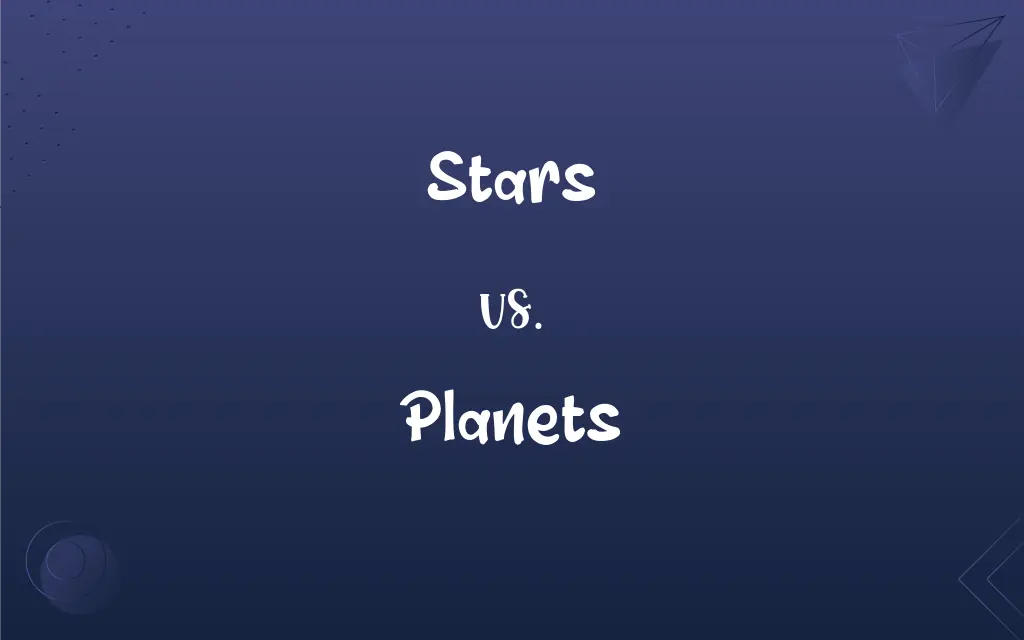Stars vs. Planets: What's the Difference?
Edited by Janet White || By Harlon Moss || Updated on June 26, 2024
Stars are luminous celestial bodies producing their own light and heat, while planets are non-luminous bodies orbiting stars.

Key Differences
Stars and planets are both celestial objects, yet they exhibit stark differences. Stars, such as the Sun, generate their own light and heat through nuclear fusion. This fusion occurs in the star's core, where hydrogen atoms are combined to form helium, releasing vast amounts of energy in the process. On the other hand, planets do not possess the capability to generate their own light or heat. Instead, they shine by reflecting the light of the star they orbit.
Furthermore, stars usually maintain a relatively fixed position in the sky from our perspective, whereas planets can be observed moving across the celestial sphere over time. This movement is due to their orbits around stars.
When considering their formation, stars are formed from the gravitational collapse of massive molecular clouds, resulting in a dense, hot core. Planets, in contrast, typically form from the dust and gas that surround a young star. They accumulate material and grow in size, orbiting the central star in the process.
When you look up at the night sky, stars appear as twinkling points of light, while planets often appear brighter and do not twinkle.
Comparison Chart
Nature
Luminous celestial bodies
Non-luminous celestial bodies
ADVERTISEMENT
Light Production
Produce their own light via nuclear fusion
Reflect light from their orbiting star
Formation
From gravitational collapse of molecular clouds
From dust and gas around young stars
Observable Movement
Relatively fixed in the sky
Move across the celestial sphere due to orbits
Twinkling
Appear as twinkling points of light
Do not twinkle and often appear brighter than stars
Stars and Planets Definitions
Stars
Bodies in space that emit light and heat energy.
At night, we can observe countless stars twinkling in the sky.
ADVERTISEMENT
Planets
Major celestial bodies reflecting light from their parent star.
The alignment of planets can be a captivating astronomical event.
Stars
Massive gaseous entities undergoing fusion reactions.
The life cycle of stars can range from millions to billions of years.
Planets
Bodies formed from dust and gas in protoplanetary disks.
Some planets may have conditions suitable for life.
Stars
Objects in the universe forming the primary components of galaxies.
The Milky Way contains a vast number of stars, each with its own unique properties.
Planets
Celestial bodies orbiting stars that do not produce their own light.
Earth is one of the eight planets orbiting the Sun.
Stars
Luminous celestial objects undergoing nuclear fusion.
The Sun is one of the billions of stars in our galaxy.
Planets
Large non-luminous objects moving in defined paths around stars.
Of all the planets in our solar system, Jupiter is the largest.
Stars
Celestial bodies that can have planetary systems orbiting them.
Many stars in our galaxy likely host their own sets of planets.
Planets
Objects in space distinguished from stars by not undergoing fusion.
Scientists are keen on studying planets outside our solar system for potential signs of life.
Stars
A celestial body that generates light and other radiant energy and consists of a mass of gas held together by its own gravity in which the energy generated by nuclear reactions in the interior is balanced by the outflow of energy to the surface, and the inward-directed gravitational forces are balanced by the outward-directed gas and radiation pressures.
Planets
In the traditional model of solar systems, a celestial body larger than an asteroid or comet, illuminated by light from a star, such as the sun, around which it revolves.
Stars
Any of the celestial bodies visible at night from Earth as relatively stationary, usually twinkling points of light.
Planets
A celestial body that orbits the sun, has sufficient mass to assume nearly a round shape, clears out dust and debris from the neighborhood around its orbit, and is not a satellite of another planet.
FAQs
Can stars have planets orbiting them?
Yes, many stars have planetary systems or exoplanets orbiting them.
Do all stars have the same lifespan?
No, a star's lifespan depends on its mass; larger stars have shorter lifespans.
Why don't planets generate their own light?
Planets do not undergo nuclear fusion, so they don't produce light; they reflect light from their parent star.
Can humans live on other planets?
No, humans can only live on earth.
Can planets have moons?
Yes, many planets have moons or natural satellites that orbit them.
Can stars be different colors?
Yes, star colors, ranging from red to blue, indicate their surface temperature.
Are all planets made of solid material?
No, while some planets like Earth are rocky, others, like Jupiter, are gaseous.
Can we see all stars with the naked eye?
No, we can only see a fraction of stars with the naked eye; many are visible only with telescopes.
What's at the center of a star?
The core is at the center of a star, where nuclear fusion occurs.
What makes stars shine?
Stars shine due to nuclear fusion reactions occurring in their cores.
How many planets are in our solar system?
There are eight recognized planets in our solar system.
How do stars form?
Stars form from the gravitational collapse of molecular clouds, leading to fusion reactions.
What are dwarf planets?
Dwarf planets are celestial bodies similar to planets but haven't cleared their orbits of other debris.
Are all stars part of a galaxy?
While most stars are part of galaxies, some rogue stars exist outside of any galaxy.
Are there planets outside our solar system?
Yes, there are many exoplanets outside our solar system orbiting other stars.
How many stars are in the Milky Way?
The Milky Way is estimated to contain over 100 billion stars.
Are planets always spherical in shape?
While not perfectly spherical, planets are generally round due to gravitational forces acting equally from all directions.
Do planets orbit only one star?
While most planets orbit a single star, there are exoplanets known to orbit binary or multiple star systems.
How do planets form?
Planets form from the accumulation of dust and gas in the protoplanetary disk around a young star.
Why do stars twinkle?
Stars twinkle because of the Earth's atmosphere bending and refracting their light.
About Author
Written by
Harlon MossHarlon is a seasoned quality moderator and accomplished content writer for Difference Wiki. An alumnus of the prestigious University of California, he earned his degree in Computer Science. Leveraging his academic background, Harlon brings a meticulous and informed perspective to his work, ensuring content accuracy and excellence.
Edited by
Janet WhiteJanet White has been an esteemed writer and blogger for Difference Wiki. Holding a Master's degree in Science and Medical Journalism from the prestigious Boston University, she has consistently demonstrated her expertise and passion for her field. When she's not immersed in her work, Janet relishes her time exercising, delving into a good book, and cherishing moments with friends and family.































































